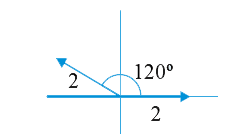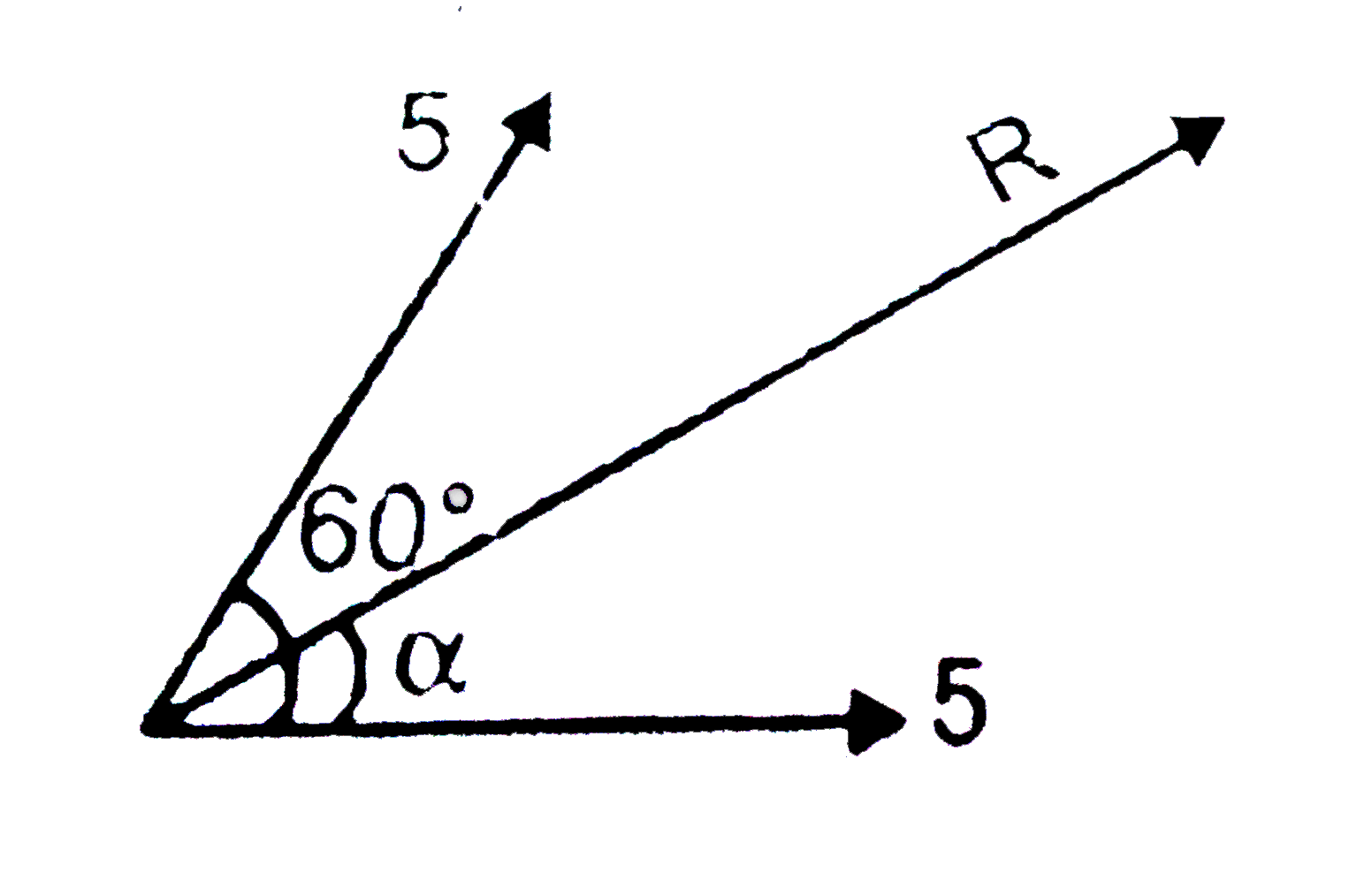The resultant of two vectors , having equal magnitudes E make an angle of 120∘ with each other . What is the magnitude and direction of the resultant ?
To solve the problem of finding the magnitude and direction of the resultant vector formed by two vectors of equal magnitude E that make an angle of 120∘ with each other, we can follow these steps:
Step 1: Understand the Vectors
We have two vectors, both of magnitude E, and they are positioned such that the angle between them is 120∘.
Step 2: Break Down the Vectors
Assume one vector →A is along the x-axis. The second vector →B will then be at an angle of 120∘ from →A.
Step 3: Calculate the Components of Each Vector
1. The components of vector →A:
- Ax=E
- Ay=0
2. The components of vector →B:
- The angle between →B and the x-axis is 120∘.
- Bx=Ecos(120∘)=E(−12)=−E2
- By=Esin(120∘)=E(√32)=E√32
Step 4: Find the Resultant Components
Now, sum the components of the two vectors to find the resultant vector →R:
- Rx=Ax+Bx=E+(−E2)=E2
- Ry=Ay+By=0+E√32=E√32
Step 5: Calculate the Magnitude of the Resultant
The magnitude of the resultant vector R can be found using the Pythagorean theorem:
R=√R2x+R2y=
⎷(E2)2+(E√32)2
=√E24+3E24=√4E24=√E2=E
Step 6: Find the Direction of the Resultant
To find the direction of the resultant vector, we can use the tangent function:
tan(α)=RyRx=E√32E2=√3
Thus, α=tan−1(√3)=60∘.
Conclusion
The magnitude of the resultant vector is E, and it makes an angle of 60∘ with the vector along the x-axis.
We have two vectors, both of magnitude E, and they are positioned such that the angle between them is 120∘.
Assume one vector →A is along the x-axis. The second vector →B will then be at an angle of 120∘ from →A.
1. The components of vector →A:
- Ax=E
- Ay=0
- The angle between →B and the x-axis is 120∘.
- Bx=Ecos(120∘)=E(−12)=−E2
- By=Esin(120∘)=E(√32)=E√32
Now, sum the components of the two vectors to find the resultant vector →R:
- Rx=Ax+Bx=E+(−E2)=E2
- Ry=Ay+By=0+E√32=E√32
The magnitude of the resultant vector R can be found using the Pythagorean theorem:
R=√R2x+R2y=
⎷(E2)2+(E√32)2
=√E24+3E24=√4E24=√E2=E
To find the direction of the resultant vector, we can use the tangent function:
tan(α)=RyRx=E√32E2=√3
Thus, α=tan−1(√3)=60∘.
The magnitude of the resultant vector is E, and it makes an angle of 60∘ with the vector along the x-axis.
Topper's Solved these Questions
- VECTORS SCALARS ELEMENTARY CALCULUS Book:ICSEChapter:VECTORS SCALARS ELEMENTARY CALCULUS Exercise:EXAMPLES
Explore 26 Videos
- VECTORS SCALARS ELEMENTARY CALCULUS Book:ICSEChapter:VECTORS SCALARS ELEMENTARY CALCULUS Exercise:Applications of integration in Physics
Explore 6 Videos
- VECTORS SCALARS ELEMENTARY CALCULUS Book:ICSEChapter:VECTORS SCALARS ELEMENTARY CALCULUS Exercise:UNSOLVED PROBLEMS
Explore 79 Videos
- UNITSBook:ICSEChapter:UNITSExercise:MODULE 3 (SELECTED PROBLEMS)
Explore 38 Videos
- WAVESBook:ICSEChapter:WAVESExercise:From Musical Sound
Explore 10 Videos
Similar Questions
Two vectors having equal magnitudes A make an angle θ with each other. Find the magnitude and direction of the resultant.
View SolutionTwo vectors having equal magnitudes A make an angle θ with eahc other. Find the magnitude and direction of the resultant.
View SolutionResultant of two vector of equal magnitude A is
View SolutionTwo vectors 3 units and 5 units are acting at 60∘ to each other .What is the magnitude and direction of the resultant ?
View SolutionFind the magnitude and direction of the resultant of given vectors

View Solutionfind the resultant of two forces each having magnitude F0 and angle between them is θ.
View SolutionThe resultant of two vectors makes an angle of 60∘ with one vector and 30∘ with one other. If the magnitude of resultant is 25, the two vectors are of magnitude
View SolutionTwo vectors having equal magnitude of 5 units, have an angle of 60∘ between them. Find the magnitude of their resultant vector and its angle from one of the vectors.

View SolutionThe resultant of two forces has magnitude 20N. One of the forces is of magnitude 20√3N and makes an angle of 30∘ with the resultant. Then what is the magnitude of the other force?
View SolutionIf three unit vectors are inclined at an angle of 60∘ with each other, then the magnitude of their resultant vector will be
View Solution